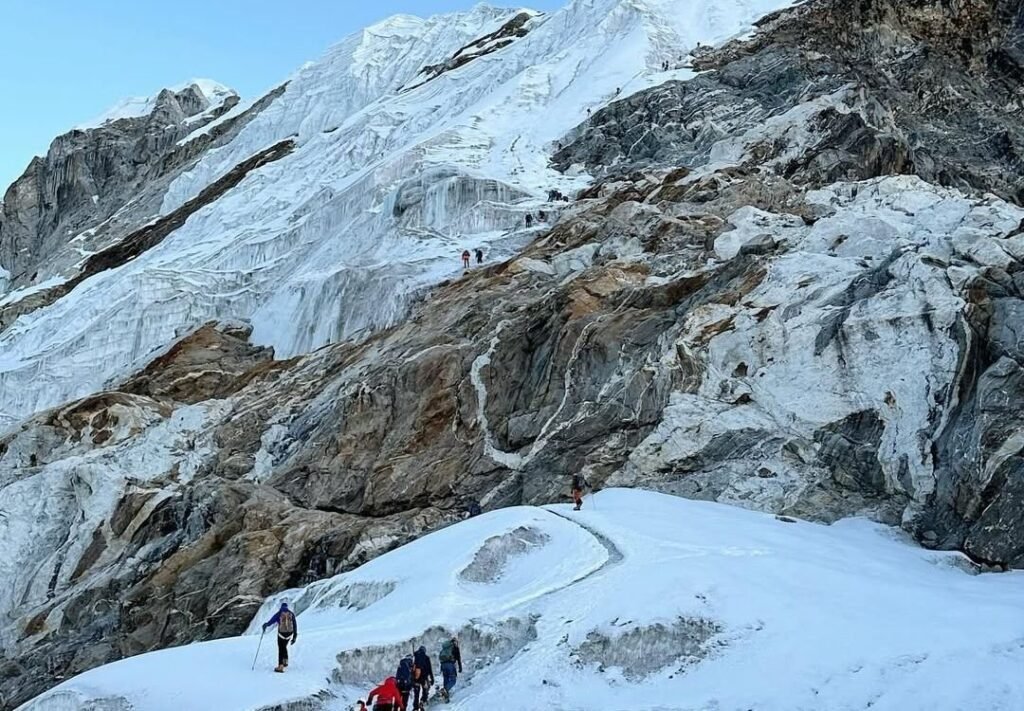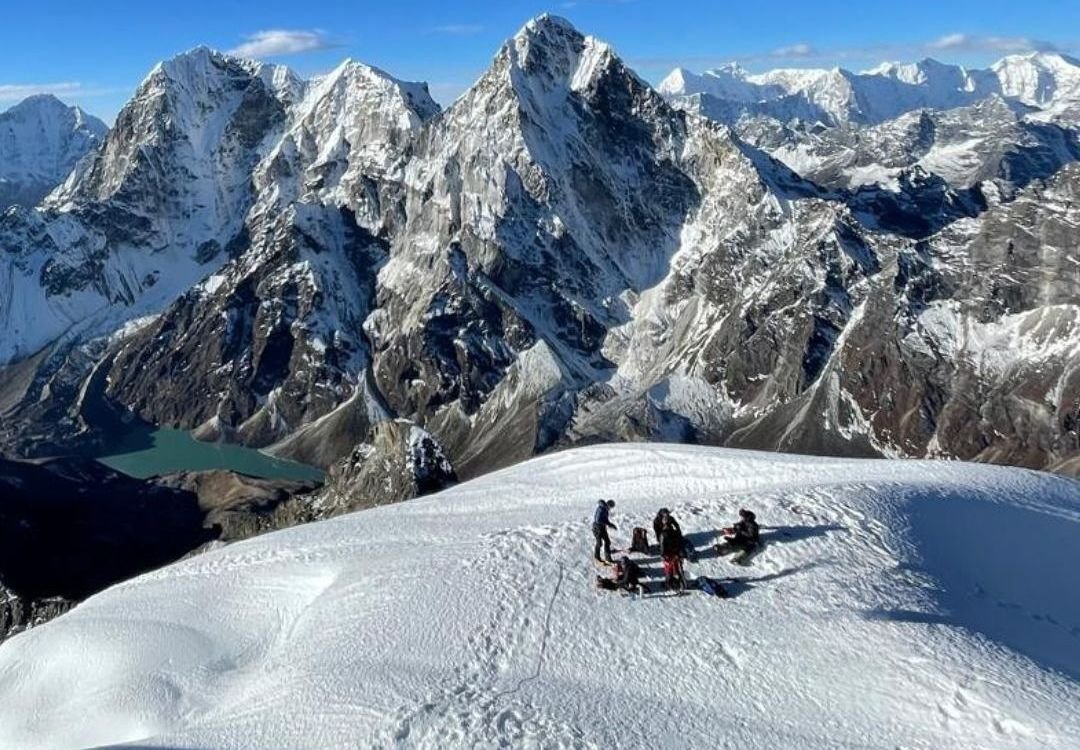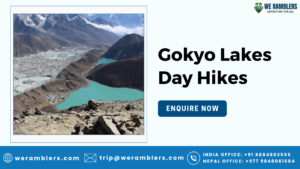Rescue During Lobuche Peak Climb: What Every Trekker Needs to Know
High above the Khumbu Valley, where the air grows thinner and the views more majestic, lies Lobuche Peak, a striking Himalayan climb that tests the spirit, stamina, and preparedness of every mountaineer. With its summit reaching 6,119 meters, Lobuche East presents a formidable challenge even to seasoned trekkers. While the rewards are extraordinary (360° views of Everest, Lhotse, and Ama Dablam), the risks associated with such high-altitude climbs are undeniable.
This blog explores the essentials of rescue during Lobuche Peak climb, highlighting everything from common emergencies to helicopter rescue options, insurance necessities, and specialized evacuation support services. Whether you’re planning your first peak attempt or returning to the Himalayas, this guide ensures you’re prepared for every possibility.
High-Altitude Exposure: The Demanding Nature of Lobuche Peak Climb
Climbing Lobuche East isn’t just another trek; it’s a technical alpine ascent that pushes your body and mind to their limits. The journey begins in Lukla and traces the classic Everest Base Camp trail through Namche Bazaar, Dingboche, and Lobuche village, before veering toward the icy ridges of the peak.
The ascent combines glacier crossings, steep ice walls, and rope-assisted scrambles, making it significantly more complex than the average high-altitude trek. Climbers deal with frigid nights, unpredictable weather, and oxygen levels that drop below 50% of sea level at the summit. It’s in these conditions that altitude sickness, fatigue, and exposure-related illnesses often surface.
Understanding the environmental stressors on this route is crucial because once above 5,000 meters, any medical complication, no matter how small, can spiral quickly. This is where being aware of rescue from the Lobuche region becomes vital.
Risks at Altitude: Understanding Emergency Scenarios on Lobuche
While climbers prepare diligently for the summit, the mountain sometimes has its own plans. On Lobuche Peak, emergencies aren’t just rare occurrences; they’re real, recurring challenges faced by many.
The Silent Threat: Altitude Illness
Altitude sickness remains the most prevalent risk, ranging from Acute Mountain Sickness (AMS) to life-threatening complications like High-Altitude Pulmonary Edema (HAPE) and High-Altitude Cerebral Edema (HACE). Symptoms often appear subtly—headaches, shortness of breath, or fatigue—but can escalate quickly, impairing judgment or mobility.
Falls, Fractures, and Fatigue
Navigating glacial terrain with technical gear can result in slips, twisted ankles, and even fractures. Icy slopes and sudden weather changes make footing unpredictable, while the physical effort of climbing with gear leaves even the fittest climbers drained. Fatigue is a frequent issue, particularly during summit attempts that begin in the dark and continue for 10+ hours.
Weather-Related Crises
The Himalayas are known for their dramatic weather swings. A sunny morning can turn into a whiteout by afternoon. Poor visibility, snowstorms, and subzero temperatures often cause disorientation or frostbite. In such conditions, timely emergency evac service in the Lobuche region can be the difference between life and loss.
How Helicopter Rescue Works in the Himalayas
When time is critical and ground rescue is unfeasible, helicopter rescue from Lobuche Peak becomes the most effective method. Helicopters operate with skilled mountain pilots who are trained to land on small, uneven, high-altitude surfaces. But the process of executing a rescue is far more coordinated than it appears.
The Rescue Chain in Motion
Once a guide identifies a medical emergency or receives a distress call, the emergency response team is activated. Details of the trekker’s location, altitude, and condition are shared via satellite phone or GPS, and the nearest helicopter operator, typically based in Kathmandu or Lukla, is contacted.
A pilot familiar with the route prepares for lift-off, sometimes requiring weather clearance from aviation authorities. Meanwhile, the ground team prepares a helipad or clearing at the nearest feasible location, often Lobuche Base Camp, Pheriche, or Dingboche. If the patient is unable to walk, they are stretchered or carried to the landing point.
From dispatch to pickup, the process usually takes 3–6 hours, depending on visibility, wind, and terrain. Patients are flown directly to hospitals in Kathmandu, where intensive care and diagnostics await.

Insurance and Costs of Rescue During the Lobuche Peak Climb
Many trekkers underestimate the Lobuche Peak rescue cost, only to face financial strain during an already distressing emergency. In reality, a helicopter rescue from high altitude can range between USD 4,000–7,000, with additional medical charges post-evacuation.
This is why travel insurance for Lobuche Peak rescue is not optional; it’s absolutely mandatory.
What to Look for in Your Insurance Plan
Ensure your policy includes:
- Emergency helicopter evacuation up to 6,200 meters
- High-altitude mountaineering coverage (often an add-on)
- Coverage for hospital bills, repatriation, and trip interruption
- Clear claim procedures and emergency hotline access
Companies like Global Rescue, IMG, and World Nomads specialize in high-altitude expedition insurance. It’s crucial to declare your itinerary honestly, as omission of peak names or elevations may void claims.
Making a Claim: Documentation Matters
After a successful rescue, our team provides incident reports, guide statements, GPS logs, and rescue invoices—all of which are necessary for reimbursement. Be sure to keep digital and physical copies of all paperwork, and if possible, communicate with your insurer from Kathmandu for guidance on next steps.
We Ramblers’ Emergency Strategy: A Safety Net Above the Clouds
What sets We Ramblers apart in the Himalayas is not just our expertise in guiding; it’s our unwavering focus on trekker safety and emergency response.
We maintain:
- A 24/7 emergency support desk in Kathmandu
- On-ground teams equipped with satellite communication
- High-altitude certified guides trained in first-aid and rescue
- Supplemental oxygen, oximeters, and evacuation protocols for every trek
- Partnerships with reliable helicopter operators and top-tier hospitals
Whether you’re dealing with altitude sickness rescue in Lobuche, or an injury during summit push, our rescue support is rapid, efficient, and always handled with care.
Working with Local Authorities: Behind Every Successful Rescue
A successful rescue from the Lobuche region isn’t a one-party operation. It involves a web of coordination with local, regional, and national stakeholders.
- TAAN (Trekking Agencies Association of Nepal) facilitates paperwork and authorizations.
- The Nepal Army and Police assist in emergencies, particularly during weather delays.
- Local guides and teahouse owners provide ground intelligence and physical support during rescues.
- Village committees and Lama networks often aid in locating lost trekkers or setting up helipads in hard-to-reach areas.
We Ramblers ensures all documentation, including incident reports, permits, and medical logs, is maintained, facilitating insurance claims and embassy communication if needed.
Prevention Before Evacuation: Reducing the Need for Rescue
The best rescue is one you never need. Here are strategies every climber should adopt to avoid medical evacuation.
Acclimatize with Intention
Never rush your ascent. Follow the “climb high, sleep low” principle, take rest days at 3,500m and 4,400m, and allow your body to adapt gradually.
Train for the Climb
Physical preparation is key. At least 8–12 weeks of cardio, strength, and endurance training before your trip can drastically reduce exhaustion and injury risk.
Monitor Your Body Constantly
Use pulse oximeters daily. Report any symptoms, however minor, to your guide. Most altitude sickness cases can be reversed with timely descent.
Stay Hydrated and Fueled
Drink 3–4 liters of water daily, and don’t skip meals. High-altitude appetite suppression is common but eating provides vital energy and warmth.
Above all, maintain honest communication with your group and guides. Your ego should never outweigh your safety.
Frequently Asked Questions (FAQs) About Rescue During Lobuche Peak Climb
How long does it take to get rescued from Lobuche?
Generally, within 3–6 hours, depending on weather and location.
Where do helicopters land for evacuation?
Common landing zones include Lobuche Base Camp, Pheriche, and Dingboche. The exact spot depends on terrain and urgency.
What if my insurance doesn’t cover the rescue?
You’ll need to cover costs upfront. That’s why confirming coverage for helicopter rescue from Lobuche Peak package is crucial before departure.
Will I be refunded if my trek ends due to rescue?
Partial refunds are subject to your trek operator’s terms. Insurance may compensate for unused services.
Can one helicopter rescue multiple trekkers?
Yes, based on weight limits and the condition of those being rescued.
Conquer the Peak with Confidence
Climbing Lobuche Peak is a powerful and unforgettable achievement. Yet, the mountain’s beauty comes with unpredictability. Preparing for the climb also means preparing for emergencies.
With We Ramblers, you’re not just another climber; we treat you like family. With helicopter rescue, emergency evac service, and trained mountain professionals at your side, you can ascend confidently, knowing you’re always protected.
So lace up, breathe deep, and chase that summit. But do it smart. Contact us now for the full itinerary and details.





